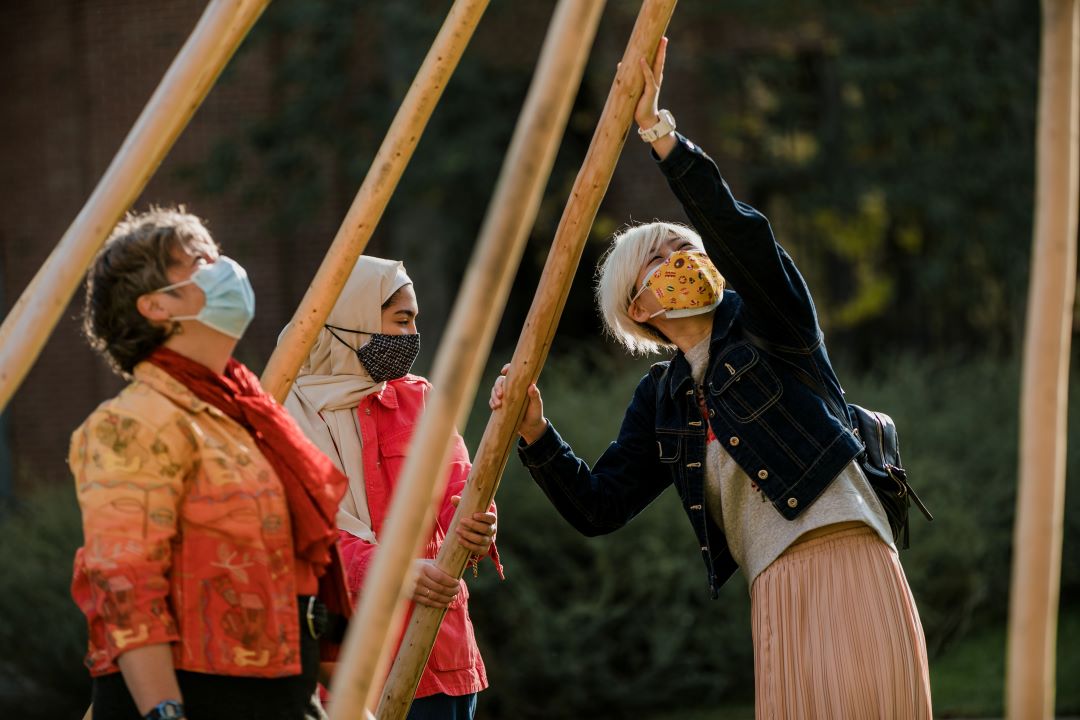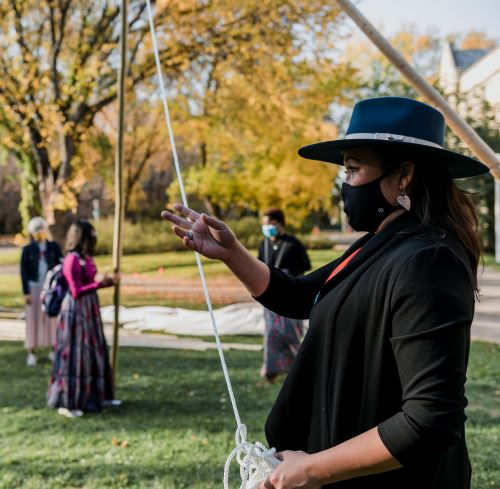
Honouring Indigenous context in engineering
FROM THOROUGH MAGAZINE: USask Engineering believes that learning about Indigenous culture and worldviews and the importance of authentic consultation are engineering practice skills needed for the next century.
By Donella HoffmanEye-opening. Powerful. Impressed. Grateful.
That’s how students from the University of Saskatchewan (USask) College of Engineering described the experience of setting up the college’s newly acquired tipi.
They were volunteers from the college’s newest crop of first years, the first students in the completely redesigned first-year program, dubbed RE-ENGINEERED.
Along with changes to student assessment and the overall structure of the program, the curriculum was broadened and includes the addition of an Indigenous Cultural Contextualization unit, taught in September as students take their first steps into the world of engineering.
“We want all of our engineering students to understand the unique relationships that exist in Canada, and certainly in Saskatchewan,” said Joel Frey, a member of the team that created RE-ENGINEERED, explaining the rationale for the prominent and intentional inclusion of Indigenous context in first-year. “The U of S, especially on Treaty 6 Territory and the Homeland of the Métis, has a unique place in the world.”
USask Engineering Dean Suzanne Kresta, who taught the unit with Frey, says placing it early in the program will help change how students think about engineering from the very beginning.
“It sets them up with engineering skills that are needed for the next century.
“We can't do engineering projects anymore without due consultation, whether it's a suburban high school or a soccer field, a highway, new real estate development or a more challenging project that runs through Indigenous lands and provides the country with critical infrastructure.
“So, starting from Day One, with consultation skills, with building an appreciation for how others see the world, we hope to change the way that they think about the profession.”
Key parts of the contextualization unit, developed with assistance from USask’s Gwenna Moss Centre for Teaching and Learning, include Indigenous culture and worldviews, the calls to action of Canada’s Truth and Reconciliation Commission, elements of the United Nations Declaration on the Rights of Indigenous People (UNDRIP) and the importance of free, prior and informed consent of Indigenous peoples before proceeding with economic development
Kresta, an engineering educator for more than 25 years, says having the dean teaching the course is essential when major change is at play. She found that, “Students are ready to come to the table and find a path forward, and that’s what we’re here to do with them.”

The highlight of the unit was the students' first experience with engineering design. They were assigned one of six Indigenous technologies - snowshoes, basket weaving, tipis, travois, hide tanning or canoe building - and had video lessons from elders on sourcing materials and making these things in a good way. This provided lessons in sustainability, the continuum of crafts, technology, engineering and functional art forms, and in reverse engineering of built objects.
Kresta was thrilled when the college’s Indigenous Initiatives Coordinator, Alana Bitsuie, launched plans to acquire a tipi and have students learn from elders about its structure and cultural significance as part of the unit. The poles were sourced from Saskatchewan elders Rose and Lester Morin of Big River First Nation, while the canvas was provided by Bruce and Deanna Starlight of the Tsuut’ina Nation in Alberta.
“This type of work is so healing for us as employees,” said Bitsuie, a member of Saskatchewan’s Red Earth First Nation. “We get to share the beauty of the culture.”
It is also a key element of how the college is strategically and thoughtfully taking steps to build respectful relationships with Indigenous communities, she said.
Because of the significance of the community raising the tipi together for the first time, Elder Tim Eashappie conducted a pipe ceremony beforehand with the students, Kresta, Frey, Bitsuie and Candace Wasacase-Lafferty, Senior Director of Indigenous Engagement at USask. The tipi was then taken down so the students could participate in raising it.
Eashappie said he appreciates “the college being gracious enough to understand that we need to work together to acknowledge and understand our First Nations ways. I think that incorporating First Nations worldview in engineering is integral to understanding science, math, technology and engineering. We were taught that everything fits together in a universal dynamic.”
Having a tipi in the college is especially significant, he said. “It is the best thing we have to be in touch with our old ancestral ways. And that’s why it was so awesome to have the tipi raising, to show that we are working together.”
Although COVID-19 concerns prevented the large gathering initially envisioned for the tipi raising, the smaller group of students who participated were clearly engaged as they learned about the cultural significance of the tipi and the Indigenous technology at play.
“I think it’s very important to learn about these aspects of this culture,” said student Mariam Alkoragaty, as she took a break from lifting and holding poles in place as the tipi was raised. “It was really informative, and I had a lot of fun today.”
This article was originally published in USask Engineering's December 2021 edition of Thorough magazine.

